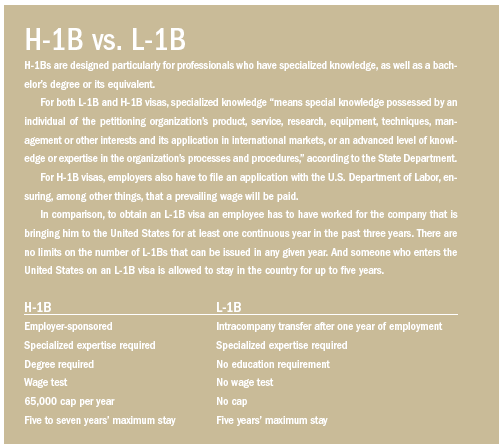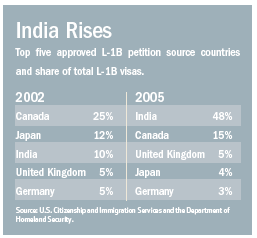 Growing use of L-1 visas and allegations of abuse are affecting all employers.
Growing use of L-1 visas and allegations of abuse are affecting all employers.
The L-1B visa has become more than just a procedure for employers transferring their foreign workers to U.S. posts for temporary assignments. The visa is now practically combustible, the center of rising discontent among some immigration and employment experts.
Many contend that the L-1B, introduced in 1970 to help multinational companies relocate key employees to posts in the United States from other countries for limited-term assignments, is being used to replace higher-paid U.S. workers with much cheaper labor from overseas. Some experts also argue that the L-1B is being used to circumvent the tighter rules and restricted availability of the familiar H-1B visa.
These critics have ammunition to back their arguments: Several high-profile abuses of the L-1B visa system spurred congressional action and led to reforms in 2004. It is unclear yet if the reforms are having the intended effect of curbing abuse or the unintended effect of adding red tape for those companies that use the visas legitimately to transfer knowledge.
What is clear is that the debate will continue as more companies become multinational and it becomes critical to their competitiveness to move their best employees—whatever their origins—into the right positions. For HR professionals, it is important to know where the debate will lead and how alleged abuses of the system may affect how they are able to use the L-1 visa in the future.
The L-1 Debate
Critics claim foreign-owned companies with operations in the United States, along with U.S. companies with operations abroad, are using L-1B visas to bring in low-cost labor to fill U.S. jobs that otherwise would go to higher-paid Americans.
To be sure, issuances of L-1 visas have shot up in recent years, particularly those used to bring information technology (IT) workers to this country from India. (L-1A visas are for executives or high-level managers; L-1B visas are for employees with specialized knowledge, such as IT professionals.)
According to figures from the U.S. Citizenship and Immigration Services (USCIS), run by the Department of Homeland Security (DHS), the number of approved L-1 petitions jumped from fewer than 30,000 in 1995 to nearly twice that number in 2000. (Unlike H-1B visas, there are no annual caps on L-1 visas.) The annual numbers of L-1 visas granted have since declined but have remained consistently above 40,000 since 2002.
From 1999 to 2004, according to a DHS report released in January, nine of the 10 companies that most often petitioned for L-1 workers were computer- and IT-related outsourcing service firms that specialize in labor from India. In addition, nearly half the L-1B visa petitions in 2005 were for Indians, far outpacing any other nationality and up significantly from only 10 percent in 2002.
The reasons for the rise in L-1B visas are subject to debate. Some see the increase as an inevitable byproduct of a growing global economy. As U.S. companies capitalize on growth markets abroad, they say, it stands to reason that firms need to transfer employees back and forth between sites to transfer expertise.
Does the same hold true for foreign-owned companies in the United States? Or are other factors at play? Are U.S. companies, as some critics allege, setting up offices abroad for the purpose of bringing in highly skilled Indian labor at lower wages?
Using L-1 Visas Legitimately
Immigration lawyers and even some critics say that most uses of L-1 visas are legitimate. “Most employers know how to use [the L-1B visa category] and use it well,” says Peter A. Yost, an immigration attorney with Faegre & Benson LLP in Minneapolis.

Typically, a company identifies a high performer in a subsidiary, provides him with additional training at corporate headquarters and then sends him back to his home country to spread his newly gained knowledge.
In fact, knowledge sharing is the primary reason for intracompany transfers, according to several companies that use L-1B visas and were interviewed for this article.
Take, for example, MoneyGram International Inc., a company that provides global money-transfer services. When it wanted to bolster its knowledge of international operations, it turned to Anand Colaco, a rising star in the company’s Dubai office. Colaco was not only helping line up agents such as grocery stores and banks to sell the company’s money orders and wires, but also providing support to the businesses if they had problems with the technology. This meant that Colaco often contacted the Minnesota headquarters if questions arose, says Kerri Keller, senior human resource generalist at MoneyGram in St. Louis Park, Minn.
The company soon realized Colaco offered a unique perspective on how the business functioned abroad, so it arranged to bring him to the United States on an L-1B visa. “He is being brought in because he’s an expert on international support. He understands what’s beyond the United States,” Keller says. “There’s nothing like having someone come in and say, ‘This is what it looks like on the front end [abroad].’ ”
Gaming the System
But for companies that use the L-1B visa the way it was originally intended, that ease of transferring key employees across borders may be at risk because of a few highly publicized cases of gaming the system. As a result, immigration lawyers claim, there are numerous other L-1 visa cases of seemingly well-qualified employees that have been rejected.
The L-1Bs have come under increased scrutiny because of alleged abuses, particularly involving Indian-owned companies. Some have been accused of using L-1B visas for employees who should be subject to the more stringent H-1B rules.
“In the computer industry, the natural category for these [applications] is the H-1B,” says Yost, who believes that raising the H-1B cap would help curtail L-1B abuses. (For a side-by-side comparison of the two visa requirements, see “H-1B vs. L-1B”.)
But applicants and companies know that L-1B visas are easier to obtain. A March article in The Economic Times, published by India’s largest media house, stated: “If the criteria can be met with, for Indians, L-1 visa is a better option than H-1B under which workers are restricted by quota numbers and have to be paid wages at the prevailing market rates, and its procedure is onerous.”
The Economic Times article rankled many who are displeased with L-1B visas. Kim Berry, president of the Programmers Guild, an organization formed during the dot-com boom to help tech workers develop their careers, says that because there are no minimum wage requirements, these visa holders “continue to work here in the United States, earning Third World wages.”
Berry says that, in theory, companies could use L-1B visas to set up shop in India for a year or two and then begin transferring Indian employees to replace U.S. workers. “It’s completely legal. It’s amazing, but it’s legal.”
In response to The Economic Times article, the U.S. Department of State released this bulletin to U.S. embassies: “There is no legal reason why aliens eligible for H-1B status cannot legitimately seek out other types of visas, including L. On the other hand, the inability of aliens to obtain H-1B visas can lead to increased fraud and abuse of the L and other categories, and posts need to be sensitive to this possibility.”
Setting Up Body Shops?
 Indian companies came under scrutiny because of concerns that they contract employees out to other companies, rather than having them work for the firm that petitioned to bring them into the United States, which is often called operating a “body shop.”
Indian companies came under scrutiny because of concerns that they contract employees out to other companies, rather than having them work for the firm that petitioned to bring them into the United States, which is often called operating a “body shop.”
Brian Graham, an immigration attorney with Winstead Sechrest & Minick PC in Austin, Texas, says that several Indian companies “sent over scores of people on L-1Bs who are not working for the parent company. They shipped them off to third-party sites left and right. This really turned the stomachs of a lot of people who saw this happen.”
There was a major uproar in 2002 when Siemens Information Communication Networks in Lake Mary, Fla., outsourced its IT department to an Indian company, Tata Consultancy Services. The U.S. workers who were being laid off were ordered to train their replacements—Indian nationals brought in on L-1 visas at lower wages.
Mike Emmons, a consultant who had worked for Siemens for six years, was one of about 20 people who lost their jobs when Tata came in. Emmons says he helped train three of the Indian replacements. “They were just average [skilled] people,” he says.
Although they were brought in on a “knowledge transfer visa,” for specialized expertise, they had to be trained on fundamental skills. Emmons says he spotted one new employee reading the introductory textbook to using the database language—a skill level well below what an L-1 visa purportedly requires.
In another contentious incident, the state of Indiana had a contract with Tata to upgrade the computer system that processes the state’s unemployment claims but had to cancel it after a public outcry in 2003. The Indian company had underbid competitors by about $8 million, and said it planned to bring in workers from India to do the job.
Mike McCabe, spokesman for Tata Consultancy Services, says that Tata is not a body shop, adding that some clients make significant use of Tata staff in the United States; others offshore work to the company, and still others use a mix of onshore and offshore staffing.
“It’s a misuse of the visa program,” argues Ron Hira, assistant professor of public policy at the Rochester Institute of Technology. He’s also the vice president for career activities of IEEE-USA, which works to support the careers of U.S. engineers. Both the H-1B and L-1B programs “can be easily gamed,” he says. Not all companies do so, he adds, “but because they can be easily gamed, they are.”
Concerning the L-1B program, Hira maintains there is a tendency “to ignore that it’s used to undercut U.S. workers by bringing in low-cost workers.” In addition, “because there are no controls over what people are being paid, it can” lower wage rates for everyone, he says.
Although companies need to be able to bring in those with specialized knowledge, Hira continues, there need to be “ways we can weed out bringing in rank-and-file personnel.”
Reforms
Indeed, in response to the Tata case in Florida, Congress moved to eliminate “body shops” by passing the L-1 Visa Reform Act of 2004. Under the measure, L-1B workers can no longer work primarily at a worksite other than that of their petitioning employer if the work will be supervised by another employer or if the person is providing labor for hire, rather than services related to the specialized knowledge of the petitioning employer. The reform measure applies to all L-1B petitions filed after June 5, 2005.
“We are of the mind that the market should dictate hiring, rather than be legislated,” says Tata’s McCabe.
In a follow-up study to the reform legislation, Homeland Security’s Office of Inspector General issued a report in January, Review of Vulnerabilities and Potential Abuses of the L-1 Visa Program, that addressed concerns with the L-1 visa program. According to the DHS report, “of the many actual and potential vulnerabilities of the L-1 visa, the body shop problem has received the most attention in the press, and during congressional hearings.”
However, the report states, “L-1 foreign IT workers represented only a small component of a much larger wave of foreign IT workers that came to the United States on temporary worker visas. The busiest year for L-1B visas, fiscal year 2000, saw more than 10 H-1B workers for every one L-1B worker. In FY 2002, the ratio was 20-to-1. Foreign IT workers may indeed have affected employment opportunities for American IT workers, but the L-1B visa would appear to be only a very small element of the problem.”
The DHS report states that it is too soon to determine the impact of the change.
The government acknowledges that, even with the reform legislation, the law is vague. The DHS report states that the L-1B program allows for the transfer of workers with specialized knowledge, “but the term is so broadly defined that adjudicators believe they have little choice but to approve almost all petitions.”
Berry of the Programmers Guild says the L-1B visa “becomes a rubber stamp because of its complexity.”
In addition, to obtain an L-1B visa, the petitioning firm has to already be doing business abroad, but DHS staff members have a hard time judging the viability of the foreign operations, particularly if they are based in remote locations in countries such as India and China, the report states. Also, because petitioners may be in the process of setting up their U.S. operation, and petitioners can transfer themselves to the United States, “windows of opportunity” are created for abuse of the system, the DHS report states.
Ripple Effects of Abuses
The bad publicity and the pressure on the U.S. government to curb abuses are complicating matters for companies that use L-1 visas legitimately.
Immigration attorney Yost, who helped MoneyGram’s Keller draw up the visa application for Colaco, recounts that he recently represented a Fortune 500 company that wanted to bring in one of its employees from Western Europe. The employee, who had worked for the company for a decade, was one of only two people within the entire organization of 20,000 employees with expertise in a certain function in a particular geographic region.
The employee seemed like a textbook case for receiving an L-1B visa. But, the USCIS rejected his application. Yost and the company argued that no one in the United States had the employee’s particular knowledge; Homeland Security officials disagreed, saying anyone with a financial background could fill the job.
Angelo A. Paparelli, an immigration attorney at Paparelli & Partners LLP in Irvine, Calif., says USCIS examiners need improved training to understand how businesses function, and why intracompany transfers are needed. He also recommends that HR managers learn to manage expectations within the company when it comes to obtaining an L-1B visa, since approval is never ensured.
Yost says, “We’ve seen denials of L-1Bs where we would have never had a denial, never would have had a request for additional information.” He thinks USCIS officials “need to deny a certain number” of applications.
Problems have arisen because of inconsistencies among the USCIS examiners who review the visa applications. In one case that Yost was involved with, an employee who had worked at a company for 10 years at a foreign location was denied an L-1B visa, while an employee at another company with only 18 months’ tenure was approved. But since April 1, all petitions for L-1B and H-1B visas are being channeled through the USCIS office in Vermont, which Yost hopes will reduce some of the inconsistencies.
Projected Growth in L-1 Visas
Unless the reforms stick or H-1B visa caps are lifted, experts say, expect continued growth in the use of L-1 visas as U.S. companies set up more operations and increase hiring abroad and as foreign companies increase their presence in the United States.
IBM India plans to double its 38,000 head count by 2010. Business process outsourcing provider EDS will hire 3,000 more people in India. Accenture is preparing to hire 10,000 people over the next two years. And Convergys, a U.S. IT firm, wants to increase its workforce to 15,000 in India. All this growth portends a continued rise in the use of L-1 visas.
Emmons, who lost his job at the Siemens facility in Florida, believes that no white-collar workers are exempt from being affected by L-1B visa holders. “If you work at a desk, there’s a risk.”
Susan Ladika has been a journalist for more than 20 years, working in both the United States and Europe. Now based in Tampa, Fla., her freelance work has ap peared in such publications as The Wall Street Journal-Europe and The Economist .
Web Extras
SHRM white papers:
An Overview of the L-1 Visa-Intracompany Transfer
Employer Sponsorship of an H-1B Visa Candidate: How to Hire the Highly Skilled Foreign Worker
Report:
Review of Vulnerabilities and Potential Abuses of the L-1 Visa Program
(Department of Homeland Security)
Reports:
Annual Flow
(Office of Immigration Statistics)
Yearbook of Immigration Statistics
(Office of Immigration Statistics)
Articles:
Ticket to US: L-1 visas edge out H-1Bs
(The Economic Times)
Special Visas' Use for Tech Workers Is Challenged (L-1)
(New York Times)
Advertisement
An organization run by AI is not a futuristic concept. Such technology is already a part of many workplaces and will continue to shape the labor market and HR. Here's how employers and employees can successfully manage generative AI and other AI-powered systems.
Advertisement


